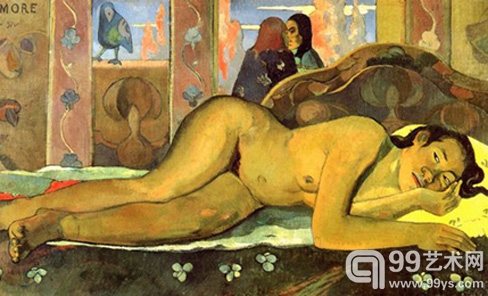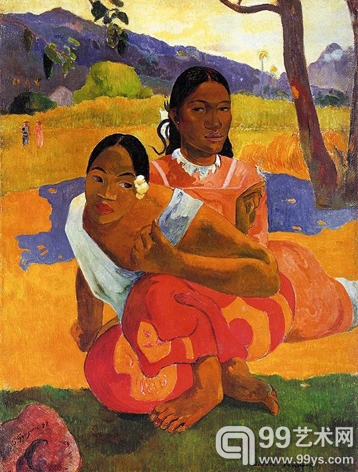|

高更笔下的塔希提岛少女
1891年,艺术家高更从马赛起航,驶向法国波利尼西亚(Polynesian)殖民地塔希提岛(Tahiti),他希望在这里看到的是一个单纯而纯洁的世界。
在接下来的12年,高更在这里创作了一批色彩鲜亮,视觉愉悦的作品,这些作品为他在艺术界带来了成功,它们也成为当代艺术发展最具影响力的作品。
然而,在泰特当代美术馆2010年年底即将举办的展览中,举办者将通过这些作品为我们解读出另一个高更,他们将就高更的这一系列作品作出另一番阐释,这些作品有意地误传了高更在南海(South
Seas)的失望,这一系列绘画是一位艺术家“以狡黠的眼光找到获利的最好时机而创作的作品”。
泰特当代的这次展览名为“高更:神话的缔造者”(Gauguin: Maker of
Myth),这次展览将是美术馆第一次在英国集中展示高更在20世纪50年代以来的作品。展览从世界各地征集了100多件作品,其中有三分之一从未在英国展出过。
通过这些作品,我们将看到一个令人触目惊心的当代艺术家:一位艺术天才,同时也是一位殖民地开发者,一个善于突击战术和制造轰动性新闻的自我宣传家。
本次展览的协助策展人贝琳达·汤姆森(Belinda
Thomson)介绍,“高更:神话的缔造者”将摒弃严格以时间顺序或者以风格面貌来展示艺术家生涯的这种展出方式,取而代之的是,这次展览将集中于高更“制造神话的趋势,在其作品中的体现,以及在艺术家自身的表现。”
在高更离开法国时,他对当时的艺术界失望至极,他认为印象主义“沦为纯粹的视觉和对光影的观察。”他想再次在艺术创作中加入智性元素,同时再次与更加单纯和真诚的世界相沟通。
然而,当高更到达塔希提岛时,“他失望地发现,欧洲传教士已经在此努力工作了很长时间,除了迷人的小女孩,那些妇女都穿着长长的衣衫在周末赶赴教堂。”
不管怎样,总体而言,高更笔下的塔希提岛的女人们都是赤裸着身子或者身着原始服装,艺术家通过这样的做法,混合了塔希提岛遥远的过去和他自己的想象。因此在《Parahi
te Marae
》这件作品中,在篱笆围着的金黄色的田野中,高更画上了一个“死神之头”,这样的图像可能源于他在巴黎时看到的毛利人在耳朵上的装饰。高更知道,这样的情景,既和这里的民族风俗相符,“又不会引发他的观众的偏见和恐怖”。
高更笔下那些裸体的女孩子正像赛西拉(Cythera,维纳斯的诞生地)中的形象,而这些形象则被法国探险者Louis-Antoine
de Bougainville大加推广。“高更没有采用任何方式在市场上销售作品,但他却着眼于艺术市场”,汤姆森这样说到。
高更是一位无可救药,也是一位具有突破性的事实操纵者,1897年,他出版了关于塔希提岛的故事《Noa
Noa》,高更宣称,这些故事是他的一位情妇收集的,但实际上,书中的大部分内容都抄袭自 J. A
Moerenhout的著作《Voyage aux les du Grand Ocan》。
在塑造形象方面,高更超越他所在的时代,他虚伪地将自己视为印加人(Inca),因为他在秘鲁长大。1889年,他将自己描绘为红发的基督,有意谴责当代,就像他朋友梵高所做的那样。
然而,高更不得不为自己的作茧自缚付出代价,汤姆森说到:“在其余生之年,在高更想回到欧洲时,他的经理人无情地对他说‘不可能,现在太迟了,你就是属于塔希提岛的艺术家’”。
对于我们这些普通观众来说,艺术家的生命总是光鲜而充满故事的,那么,艺术家又有什么不为人知的地方呢,跟随泰特当代的解读,我们去理解另一个高更。

高更Parahi te Marae
对于我们这些普通观众来说,艺术家的生命总是光鲜而充满故事的,那么,艺术家又有什么不为人知的地方呢,跟随泰特当代的解读,我们去理解另一个高更。

Tate Modern exhibition explores the myths behind
artist Paul Gauguin
In 1891 the painter Paul Gauguin set sail from Marseilles
bound for the French Polynesian colony of Tahiti and what he hoped
was a purer, more innocent world.
The vibrant and sensual images that he created there during
the remaining 12 years of his life are among the most instantly
recognisable and influential in modern art.
However, as an ambitious exhibition later this year will make
clear, they were also wilful misrepresentations of what a
disappointed Gauguin found in the South Seas, produced by an artist
“with a canny eye to the main chance”.
Gauguin: Maker of Myth, at Tate Modern from September, will be
the first major retrospective of the artist in Britain since the
1950s.
It will bring together more than 100 works from around the
world, about a third of which have never been shown in Britain
before.
Together they will depict a strikingly modern artist: a
monstrous, exploitative, lying self-publicist with a flair for
shock tactics and sensationalism who also happened to be a
genius.
Belinda Thomson, the co-curator of the exhibition, said
yesterday that the show would steer away from a strict
chronological or stylistic examination of his career and instead
focus on “the tendency towards myth-making, in his work and his
presentation of himself”.
By the time that Gauguin left France he was thoroughly
disillusioned with the art world. According to Ms Thomson, he
thought that Impressionism “had been reduced to the eye and
observations of light”. He wanted to reintroduce intellectual depth
to creating art as well as reconnecting with a more naive and
honest way of life.
However, when Gauguin arrived in Tahiti “he was disappointed
to find European missionaries had been hard at work for a long
time. Instead of luscious girls, he found women dressed up to the
neck in smocks and going to church on Sunday”.
By and large he painted them naked or primitively dressed
anyway, a concoction between the distant past and his own
imagination. So in Parahi te Marae (1892), a yellow field is
circled with a fence decorated with an invented “death’s head”
design, probably taken from a Maori earplug he had seen in Paris.
Gauguin knew that the scene would tap into clichd beliefs in
Polynesian cannibalism and “was not above playing to the prejudices
and fears of his audience”.
His naked young girls fitted the image of Tahiti as the new
Cythera (birthplace of Venus) popularised by the French explorer
Louis-Antoine de Bougainville. “He’s not selling out to the market
by any means because he’s always creating difficult work, but at
the same time he had an eye on the market,” Ms Thomson said.
Gauguin was an incorrigible and groundbreaking manipulator of
the truth, she added. In 1897 he published Noa Noa, Tahitian
stories that he claimed to have gleaned from one of his mistresses.
In reality he had copied them out of J. A Moerenhout’s book Voyage
aux les du Grand Ocan.
The artist was ahead of his time in the way that he
constructed his image, referring to himself (falsely) as an Inca
because of his upbringing in Peru. He deliberately alarmed
contemporaries when he painted himself in 1889 as Christ with red
hair like his friend Van Gogh, in Christ in the Garden of
Olives.
Eventually he was forced to live out the consequences of his
self-promotion, Ms Thomson said. “Towards the end of his life he
wanted to come back to Europe but his dealer said, ‘No, it’s too
late. You are the artist over there.’ ”
|